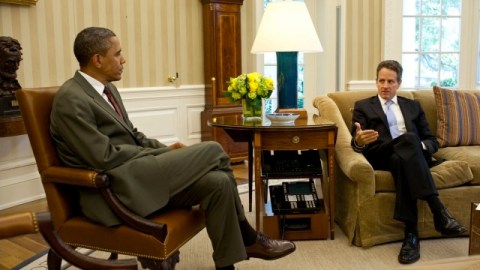What Rating Should Standard & Poor’s Ratings Get?

Friday, for the first time, Standard & Poor’s lowered its evaluation of the U.S. government’s credit rating, downgrading it from AAA to AA+. According to S&P’s rating system, that means revising its assessment of the federal government’s capacity to meet its financial commitments from “extremely strong” to “very strong.” It’s not very clear just what that means. But what is clear is that the S&P ratings are practically worthless.
Stocks fell across the board on the first trading since the credit downgrade. But, as Paul Krugman says, if investors were particularly concerned about the security of U.S. debt, treasury yields would be rising. Instead the yield on 10-year treasuries plummeted this morning as investors moved to buy U.S. debt, reflecting a widespread belief that it is still the safest investment available.
The U.S. government’s capacity to pay its debt certainly seems extremely strong, although it would be a mistake to think of any investment as completely safe. Although the federal government’s deficit spending is unsustainable in the long-run, the U.S is hardly broke. What is in question is not the government’s capacity to pay its debts, but its political willingness to do so. S&P is certainly right to point out that both parties have been willing to use the threat default for political leverage (although Democrats did push for a debt ceiling increase without any conditions), and that the recent debt ceiling deal does little to improve the U.S. government’s long-term fiscal outlook.
But if you’re going to have doubts about the whether the U.S. government will pay its debts, it shouldn’t be on the basis of S&P’s analysis. One of the rating agency’s main points was that the U.S. debt was growing too large as a percent of the country’s GDP. But as the Treasury Department noted almost as soon as a draft of the release was issued, the rating agency made a $2 trillion mistake in its projections. The S&P’s revised numbers show that the U.S.’ debt-to-GDP ratio should continue to be well in line with other AAA-rated countries. Economics of Contempt recalled a managing director of S&P who didn’t even know the conventional order of mathematical operations and wrote that “to say that S&P analysts aren’t the sharpest tools in the drawer is a massive understatement.”
In fact, Nate Silver has found that S&P ratings correlate strongly with subjective judgments about countries political systems, and that historically they have practically worthless as predictors of the risk of government default. Never mind that, as Paul Krugman points out, S&P and the other credit rating agencies gave AAA ratings to the shoddy mortgage-backed assets at the center of the recent financial crisis. S&P even gave Lehman brothers an A rating until just before it went bankrupt. The truth is that S&P has little credibility as an objective or accurate evaluator of the soundness of investments. It seems to do little more than reinforce conventional judgments, and , as Mark Seddon says, it is a largely unaccountable to anyone for their ratings. “No matter what some agency may say, we’ve always been and always will be a triple-A country,” Obama said in statement this morning, adding that “we didn’t need a rating agency to tell us that the gridlock in Washington has not been constructive.”
Photo credit: Pete Souza





